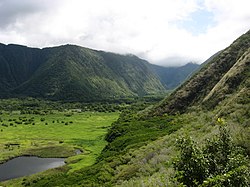Waipi‘o Valley
valley on Hawaii Island, Hawaii From Wikipedia, the free encyclopedia
Remove ads
Waipiʻo Valley is a valley on Hawaiʻi Island, in the U.S. state of Hawaiʻi. It is located in Hāmākua District, in the northeast of the island. Wai piʻo means "bent water" in Hawaiian.[1]
The valley floor, at sea level, is nearly 2,000 feet (610 m) below the surrounding plateau. The valley was formed by water erosion of the weak basaltic lava from the Kohala volcano.[2]
The valley's coast is a black (lava) sand beach popular with surfers. There are several taro farms in the valley.[3] Several large waterfalls plunge into the valley and feed the river, which flows from the foot of the largest waterfall at the back of the valley to the sea.[4]
Waipiʻo Valley plays an important role in Hawaiian religion, as it is the gateway to Lua-o-Milu (the underworld), hidden by the sand. The valley was also considered a puʻuhonua (place of asylum), where those who broke kapu were protected.[5]
Access is difficult. Only one road leads there from the south. It climbs 800 feet (240 m) in 0.6 miles (1.0 km), with an average gradient of 25%, sometimes considerably steeper. Some sections can reach gradients of up to 45%, making it the steepest road in the United States[6] and possibly the steepest in the world, compared to 35% for Baldwin Street in New Zealand.[7][8][9] The road is only accessible to 4x4 vehicles.[1]
The 2006 Hawaiʻi earthquake caused a cliff at the entrance to Waipiʻo Valley to collapse and slide into the sea, and also caused rocks to fall on the access road leading to the valley.[10]
The valley is the setting for the final scene of the science fiction movie Waterworld (1995), in which the main characters find Dryland, the mainland.[1]
Remove ads
Image gallery
- View of the back of Waipiʻo Valley.
- View of the back of Waipiʻo Valley.
- Hiʻilawe Waterfall at the back of Waipiʻo Valley.
- Waipiʻo Valley cliff falling in during the 2006 Hawaiʻi earthquake.
- Waipiʻo Valley seen from the access road, which has an average gradient of 25%.
References
Other websites
Wikiwand - on
Seamless Wikipedia browsing. On steroids.
Remove ads







